Bicycle vacation Myanmar
Gorgeous landscapes and friendly people
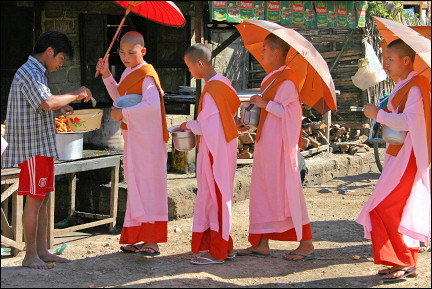 |
Bicycling tour through a country with more stupas and buddha statues than inhabitants. Gold leaf shines everywhere. On bad roads through beautiful landscapes around Mandalay, along Bagan (with thousands of old stupas) and Nyaung Shwe on Lake Inle. Via Yangon, with its impressive Shwedagon Paya, to Ngwe Saung on the Gulf of Bengal and Pathein on the Ayeyarwady River.
Travelogue & photos: Gerrie & Aart Dijkzeul
We just washed the dishes after Christmas dinner and before we know what's happening we have flown from Amsterdam, The Netherlands to Myanmar (formerly Burma) and find ourselves strolling through its former capital Yangon (Rangoon).
Yangon
Shwedagon Paya sparkles and shines with gold leaf
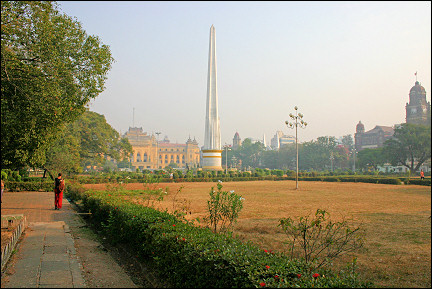 |
Yangon has a population of 5 million. After the government moved to Naypyidaw in November 2005, Yangon is no longer Myanmar's capital. The official reason for the move is the central location of the new capital.
According to some Burma watchers however, strategic considerations were also important. Slowing down an invasion in the event of an American attack as well as the shorter distance between military headquarters and the regions where the army still is fighting ethnic insurrections are mentioned as factors.
Whatever the reason, it fits the longstanding Birmese tradition of building ever new capitals.
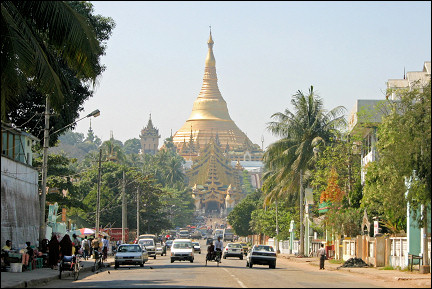 |
But it does not fit our bicycling plans. It turns out that foreigners are not allowed near the new capital. Because of this we cannot bicycle from Yangon to Mandalay and have to take the train.
Our very first visit in Yangon is to Shwedagon Paya (paya is a general expression for religious places like temples, stupas, etc.). On the top of a hill sits an almost hundred meters high stupa in the shape of a bell, surrounded by many temples and smaller stupas. Their shapes and colors make them look like fairy tale buildings in Disney World. Many sculptures of Buddha, nats (spirits) and animals.
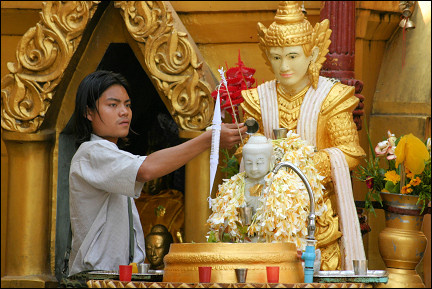 |
Gold paint and gold leaf make everything sparkle and shine. It is impressive, not just because of the scale of the whole thing and the "bling", but mostly because it is so "alive." There aren't many tourists, the majority are Birmese who come to pay their respects and pray to the Buddha.
People light incense and put flowers in vases. When they're done, they open a bag and the whole family eats the food they brought with them.
Mandalay
Temples, palaces and a Buddhist university
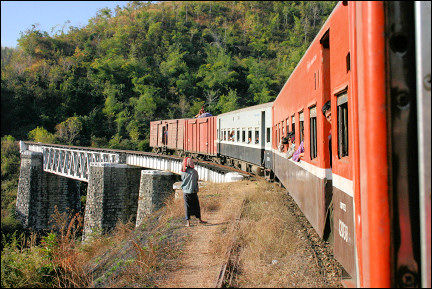 |
On Sunday we rise at 3 AM to catch the train to Mandalay. In the train station we need to take care of a lot of red tape: passports, receipts, reservation papers. Everything is checked, written down and checked again.
We bump through the Birmese landscape for 15 hours, in which we cover 700 kilomters (no stops on the way). Not very fast. We don't need the container of chocolate paste we brought in case we snowed in: there is enough food available in the train.
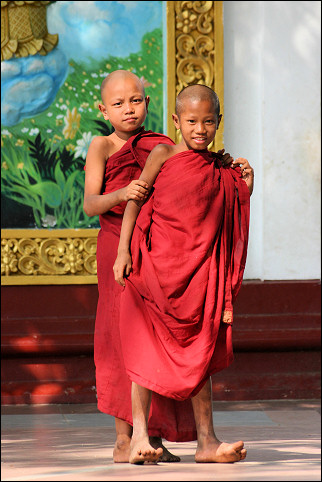 |
Retrieving our bikes, which arrive on a later train, turns out not to be easy. The man we show our receipt says we have to be at the other end of the train station. He accompanies us. The other place isn't the right one, either; the guy in charge there also joins us on our quest, together with a group of onlookers.
They walk fast: on the tracks, between trains, through trains. Is that guy a traveler or the man with our receipt? We've lost track of him as well as of our receipt. Luckily, the guy finds us. And, after half an hour, we are reunited with our faithful bikes.
We spend New Year's Day visiting temples and palaces in Mandalay. A novice (monk in training) takes the opportunity to practice his English and tells us everything about his life as a student at the Buddhist university.
He tells us about his daily routine and the choice he'll have to make: to become a monk or - as they call it - "to put down the robes." Because even novices are vulnarable to the charms of beautiful Birmese women.
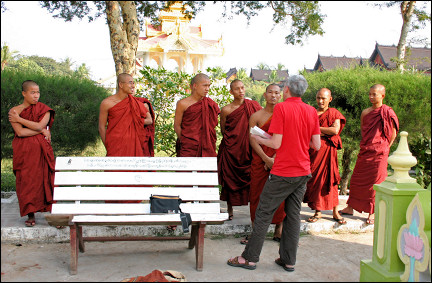 |
Nothing is more relaxing than reading a book at the end of the day in an almost deserted and cool pagoda.
Sagaing, Monywa and Pakokku
Men and women spread white powder on their faces
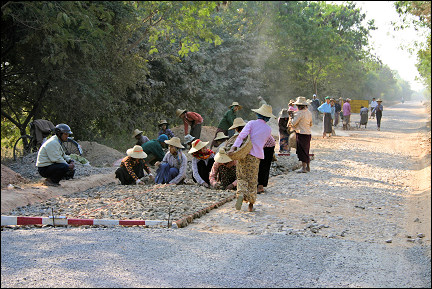 |
Today the real thing begins: we bicycle to Sagaing and the three days after today to Monywa, Pakokku and Bagan. It is worse than we expected. Not so much because of the distances (two days in a row 110 km a day), but mainly because of the condition of the roads.
If it is an asphalted road, it is so bumpy and full of potholes that our waterflasks fall from their holders. If it is a dirt road, we get stuck in sand or bounce up and down on a mixture of broken bricks and sand.
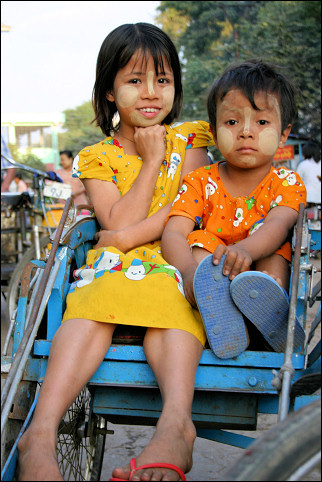 |
An unpleasant side effect is that we don't see much of the surroundings. We have to keep our eyes on the road to avoid bumps and potholes. If it stays this way, we'll take the bus.
The towns where we spend the nights are not equipped for tourists. Almost nobody speaks English, so we have to communicate with hands and feet. But that goes well. We even succeed in finding oil for our bicycle chains, by drawing a flask of sowing machine oil with drops coming out of it and a bicycle chain. They do not allow us to pay for it. The oil we brought with us has been absorbed by the bicycle bag.
Our general impression of the Birmese: friendly people with longyi's (long robes wrapped around the body, worn by men and women) and thanakha on their faces.
Thanakha is a white powder, made of wood, which serves both as make up and sun block.
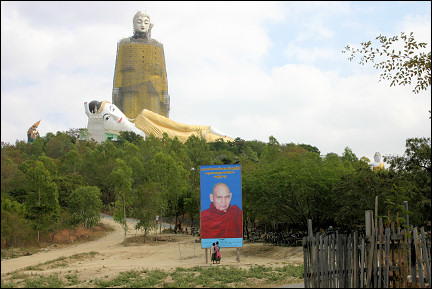 |
Near Monywa we visit two giant Buddhas. The standing one, which will be over a 100 meters high, is still under construction. The scaffolding is made of bamboo sticks. Very impressive.
Bagan
Thousands of old stupas, temples and palaces
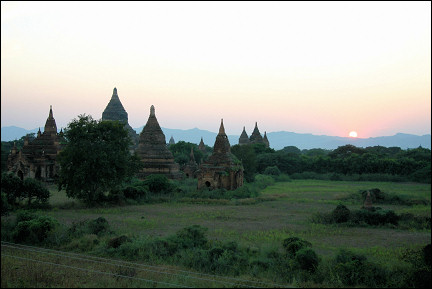 |
After a few days of bumpy roads it's good to be in Bagan. Together with Lake Inle it is the most important tourist attraction of the country. To stay for a few days in a tourist resort with all its comforts is not such a bad thing.
We can make ourselves understood again, we can send e-mails and - important - can have a Western breakfast instead of rice with a fried egg and fish-flour stew.
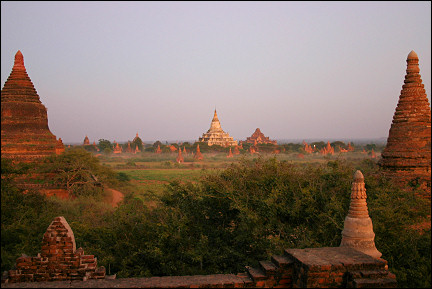 |
Bagan owes its fame to an area of 40 square kilometers with thousands of ancient stupas, temples and palaces, dating from 1000-1250. Some are deserted, others are still visited by many Birmese.
What they have in common are Buddha statues, measuring from a few centimeters to tens of meters high. Near one of them little pieces of gold leaf are sold: people stick them to the Buddha's feet. Higher is impossible without a ladder.
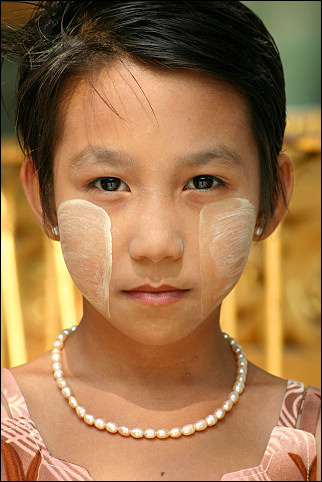 |
We take three days to explore the area. We bicycle on the sand paths that connect the temples. We stop at one of them and climb via a dark stairway to the porch where we have a great view of the surroundings.
When we return to our bikes, it turns out that a sharp thorn has punctured a tyre. The second one in 24 hours! Luckily we have a repair set with us, unfortunately not a bicycle pump. The only thing we can do is go back to our hotel, 5 kilometers. When Aart is almost on his bicycle, a boy offers to get us a bicycle pump; it turns out he lives nearby the temple. Within 15 minutes we have fixed the tyre and continue our ride.
In the three days we cross the area we see only a handful of the 700.000 tourists who visit Burma every year. Maybe because a large part of them are Asian and for us not recognizable as tourists.
At the center of the area is a big, crowded market with vegetables, fruit, souvenirs and cheap clothes. We have lunch in a typical Birmese teashop. When we sit, our knees reach our necks, because the furniture appears to be taken from a dollhouse.
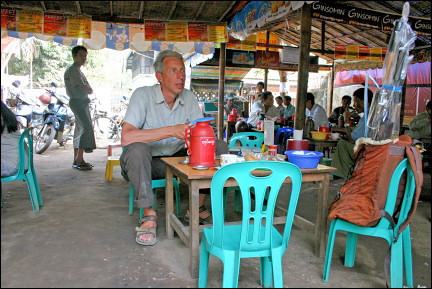 |
Sanity does not seem to be a top priority. The waiter pours some tea from the pot on the table and mops it up with a cloth that doesn't look as if it gets rinsed very often.
There is no running water. Water is brought in an oil drum which is carried on a frame with truck wheels, pulled by a man.
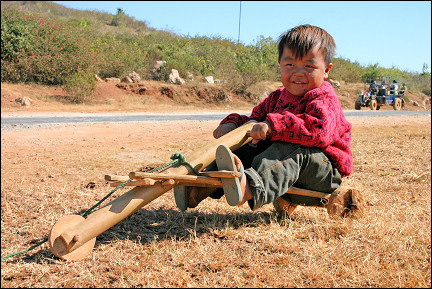 |
We drink tea from cups which after use are put back in a bowl of water on the table. The next customer takes it from the bowl and uses it again. Just like in a European tearoom, we are offered all kinds of baked goods: springrolls, vegetarian pig-in-blanket's and fried fruit dumplings.
The "oliebollen" (Dutch fried sweet dough balls)we eat could certainly compete in the annual "best oliebol" election organized by a newspaper in The Netherlands.
Meiktila, Thazi and Kalaw
The train weaves it way through hairpin bends
After three days of enjoying the peacefulness of ancient temples and the comforts of a tourist resort, we leave for Popa. In the next few days we'll successively visit Meiktila, Thazi, Kalaw and Nyaung Shwe.
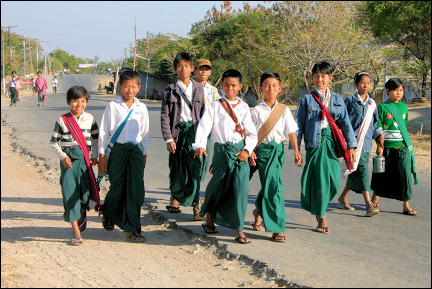 |
During the first three days the roads are reasonably good. Sometimes a little steep - steep enough for a friendly Birmese, who can't bear seeing Gerrie struggle any longer, to push him up the mountain for a few hundred meters.
One hour from Bagan we are overtaken by two kids on a moped. They ask us the standard questions: "where are you from" and "where do you go." Our answer to the last question makes them stop at once. We're on the wrong way. We missed an exit 15 km ago.
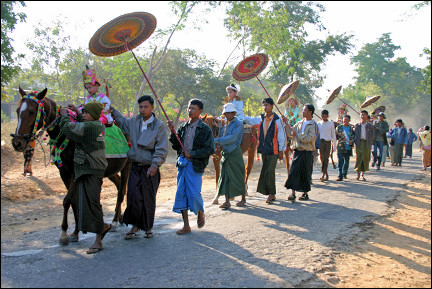 |
But because of this negligence we are now witnessing a village festivity. Children with beautifully painted faces, dressed in traditional garb, on horseback and in ox-carts, move in procession, accompanied by music.
Because we can't find anyone who speaks English, it remains a mystery to us what the reason for the festivity is.
There is a lot to see on the road. We stop at a workshop where a man in longyi climbs a palmtree. Not to get coconuts, but to milk the liquid that drips from cuts in the leaves. The liquid is collected in a coconut shell. This liquid is then the base for palm sugar and - after fermentation - alcohol and beer.
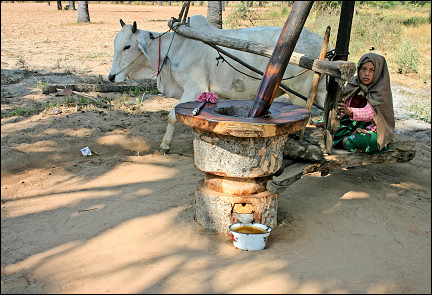 |
In the same workshop peanut oil is harvested. It is a wonderful sight: pre-colonial technology. A wooden mortar, a woman who uses her weight to put pressure on it and an ox walking in circles to turn the mortar.
The road from Thazi to Kalaw is described as "very bad". With our earlier experience with roads which were described as just "bad" in mind, we decide to take the train. "Upperclass." One side of the back of my seat is straight, the other leans all the way back; the springs in the seat are showing.
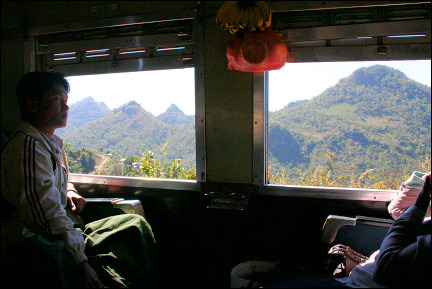 |
The 5 AM train leaves at 7:30 AM. We promise never to complain again about the trains in Holland. But, we have to admit, it is a wonderful trip. Because hairpins are hard for trains, it sometimes zig-zags its way up: a little bit forward, then back again.
All this ascending takes us eventually up to 1300 meters, which we notice because of the temperature. We put on socks and fleece jackets. A little later, around 9 AM, the temperature has risen to 20 degrees Centigrade again, fortunately.
Nyaung Shwe
Floating fields of waterhyacinthus on Lake Inle
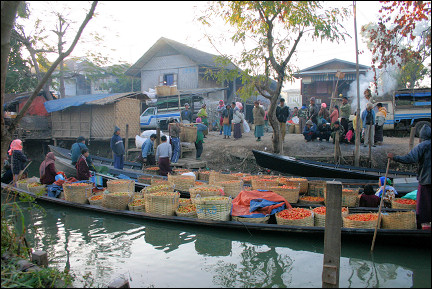 |
We stay for two days in Naung Shwe, a tourist magnet because of Lake Inle. We thought Holland was unique in winning land from water, but Burma also seems to be really good at it.
Everywhere we look, parts of the lake are being made into land by fixing floating fields of waterhyacinthus with poles to the bottom of the lake. After it is completely overgrown and filled wit mud, the parcels will be used to plant tomatoes, beans or sugar-cane.
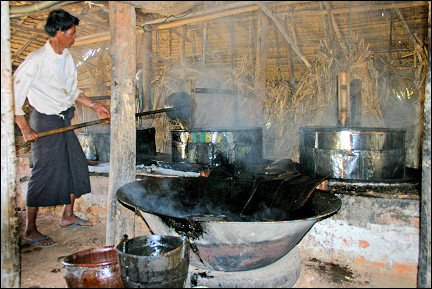 |
We take a bicycling trip along Lake Inle. Fifteen kilometers of sand path take us along sugar-cane fields and workshops where the cane is harvested and its juice is boiled until it is syrupy. It is wonderful to see and smell these traditional methods being used.
Because we prefer not to ride back the same way, we try to hitch a boat ride in a town where the market has just closed, to Naung Shwe. We get a ride on a cargo boat which carries unsold merchandise.
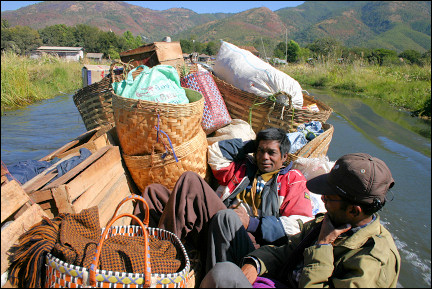 |
After all merchandise is loaded onto the longboat, the bicycles are put on top of everything. Passengers find space for themselves between the crates and baskets; we get the places of honor on top of a chest. The trip lasts over half an hour and takes us along a village and vegetable fields floating on the water.
Next day we bicycle along the other side of the lake to the hot baths. They're not as great as we thought: a little pool in which a few people are bathing. The hot water comes from a well some ten meters away. Half-way between the well and the pool a family who's had a picnic there, is doing their dishes. Nobody else seems to mind, but we decide to pass on the bath.
Pindaya, Ywa Ngan and Kyaukse
Beautiful views and pristine nature
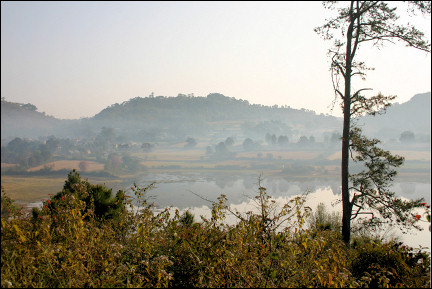 |
It's high time to continue our trip around Mandalay. We will return to our starting point Mandalay in four stages, a distance of 330 km with three stops on the way: Pindaya, Ywa Ngan and Kyaukse.
It is a beautiful route, with mountains and hardly any traffic. At times it's hard. Even in lightest gear we every now and then just make it. Two thirds of the roads we take are in reasonable condition. The rest is a disaster, which is a pity, certainly when we're descending: even at a 10 percent descent we don't go faster than 12 k.p.h. on bad roads.
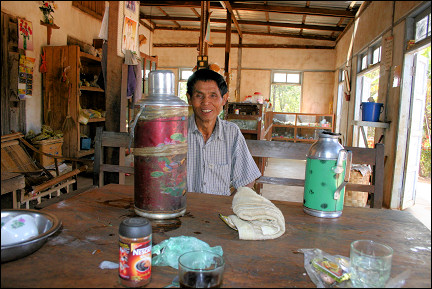 |
We drink tea and have lunch in teashops, which you'll find in every small village; restaurants you'll only find in larger villages. The owner of one of the teashops where we have lunch is fascinated by the fact that he has two foreign guests: he joins us at our table.
But the extent and depth of our conversation are limited by language problems - the man doesn't speak a word of English.
The day, week, and year markets we see on the way are experiences in their own right. Tasty food and colorful people of different ethnic minorities. We watch them curiously. And they look at us with at least the same amount of curiosity.
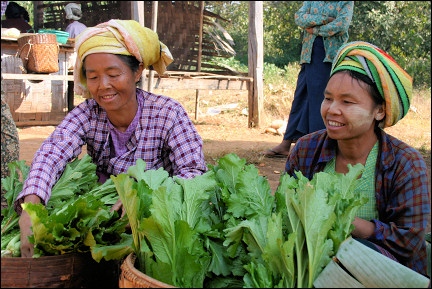 |
At one of our rehydration stops, a man with a huge basket of freshly harvested tangerines stops and insists we accept a bunch of them. How nice of him.
Because this area is sparsely populated, there aren't many places to spend the night. In Ywa Ngan there is exactly one. Unfortunately, the owner doesn't have a permit to have foreign guests. Bicycling to the next guesthouse at 80 kilometers from here is not an option.
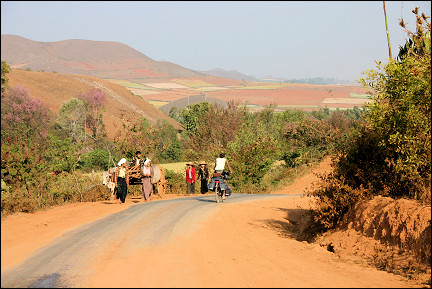 |
So we trot to the police station to get a permit to spend the night in the guesthouse. That turns out to be easy - after some red tape. Within half an hour we have their permission.
The guesthouse is rather basic. We can wash ourselves outside at a mandibak behind a bamboo screen. We sleep in a shed with a bed. At night we notice that the walls are thin: our neighbors snore, hawk and burp. Our earplugs are no match for the noise. Next night in Kyaukse it's the same way.
But these little discomforts are amply compensated for by the quiet and beauty of the area where we are bicycling. Stunning views, pristine nature and - by the end of the route - a valley with a big, meandering river.
Via Yangon to the coast
Many kilometers along small paddies surrounded by dykes
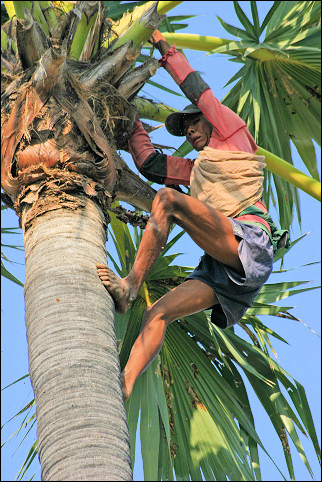 |
Back in Mandalay we take some time after breakfast to go over our traveling schedule for the rest of our trip. While we're counting the days we've been on the road, it turns out that today is the 21st, not the 20th. This means that the train we'd booked for the 21st to Yangon left five hours ago. Dumb, dumb, dumb.
In the train station we try to find out if anything can be done. We probably are going to have to buy new tickets: again 42 dollars each (tourist price, the Birmese pay only 2.5 dollars, which we think is a good thing).
From the teller to the station master. An important man in a poche chair. He listens to our story and tells us that the rule is that if you miss the train, you have to report within two hours. We're too late, in other words. But because we're foreigners he can't make the decision himself.
He calls headquarters. It's okay: the date on the ticket is changed, new seats are assigned, signatures are placed and then we're ready.
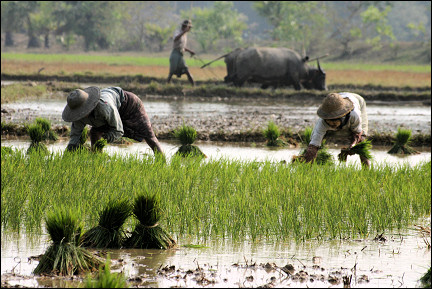 |
At 4 AM we're on the train and travel back to Yangon in 15 hours. There we leave for the coast. Because the first stage to Pathein is very long and there are no guesthouses on the way, we travel on a pick-up truck for the first 80 kilometers.
The next 100 kilometers we bicycle through the delta of the Ayeyarwady river. Many kilometers along small paddies surrounded by dykes, where the plowing and planting is done respectively by oxen and human hands. We hardly ever see anything even remotely looking like a tractor.
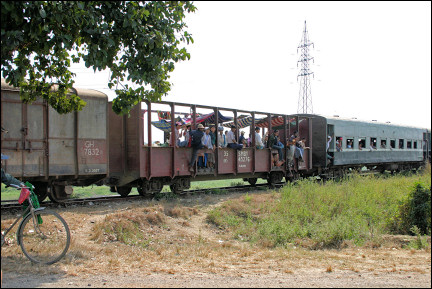 |
The last 30 kilometers we bicycle next to the local train. At a train crossing the passengers in the open car wave at us enthousiastically.
Next day we bicycle to Ngwe Saung. The route is beautiful, with unexpected climbs and descents through a mostly pristine jungle. Who would've expected hills up to 500 meters in a river delta?
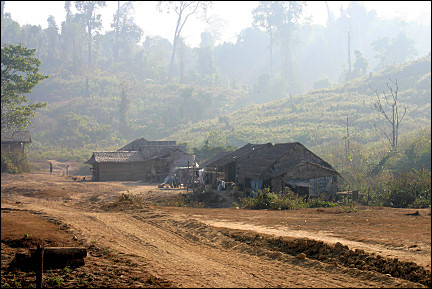 |
And there is the Gulf of Bengal: silver-white sand, clear water (over 25 degrees Centigrade), a cabin on the sea and a beach visitor population of less than one per 100 meters beach. Two days of reading, swimming, walking. No problem.
Pathein
It's busy along the river
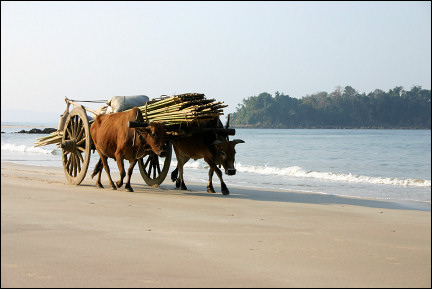 |
From the Gulf of Bengal we bicycle back to Pathein. It is a lively city on the river. One of our favorite activities here is just observing what goes on in one of the local pagodas.
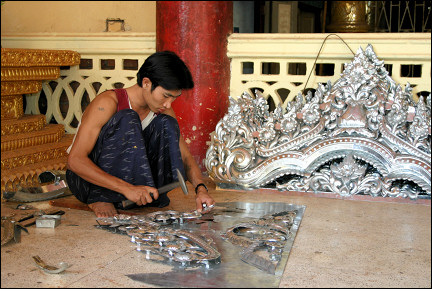 |
Metalworkers are making new metal ornaments. With a kind of coumtry-fair attraction people are tempted to buy gold leaf for the stupa; the bought gold leaf is transported to the stupa in a kitschy, illuminated gondola hanging from a cable.
We don't get bored easily watching the crowds on and along the river. Many little rowing boats take people and cargo to the other side. They are propelled by someone who rows standing straight up in the rear of the boat. It looks like impossible movements to make, but the boats go reasonably fast.
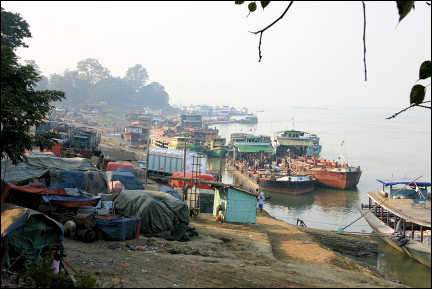 |
The river is also used by rickety old ships which transport incredible amounts of rice, charcoal and every other kind of cargo.
Loading is done manually. 200 liters oil barrels are rolled down the quay and then up again over two planks onto the ship. Impossibly heavy crates filled with stones are shlepped, shuffled and carried on board. And all of this is done wearing slippers. Security boots and standards for maximum weights that can be carried are unheard of here.
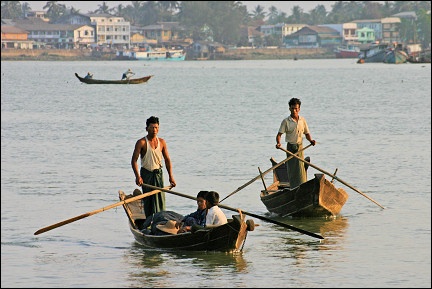 |
We take a recreational bike tour near Pathein. The route we have plotted on the map is hard to follow. The map is outdated and inaccurate, as we soon will find out.
The bridge under construction on the map was finished over ten years ago and is also 15 kilometers farther to the south than the map indicates.
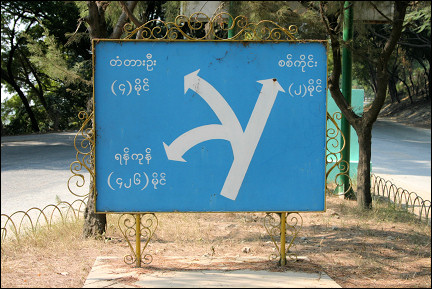 |
The traffic signs in Birmese are Chinese to us and the directions we get from locals aren't much better. We don't know how to pronounce the names of towns (which are written in Latin script on the map).
Also, they just point randomly. We ask three different people in five minutes and we are sent three different ways. Eventually we decide to use the sun as a compass. First we head east for a long while and then keep going south. Soon we are struggling with our bicycles on inaccessable sandpaths. But the surroundings are gorgeous.
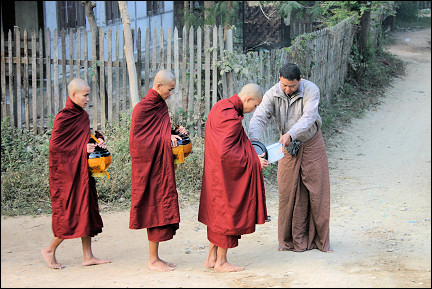 |
After half an hour we suddenly see big school buildings and ride on neatly asphalted roads, about which the map didn't tell us anything. When we are stopped by a sour-looking soldier, we understand why: it is a military base and we are not supposed to be here.
After five minutes of fruitless conversation, he in Birmese and we in Dutch, we ask in what direction Pathein is. His colleague, who joined us, points south. We say "cezubèh" (thanks) and bicycle innocently in that direction. When we look back after 300 meters, the view is reassuring: they are still standing there.
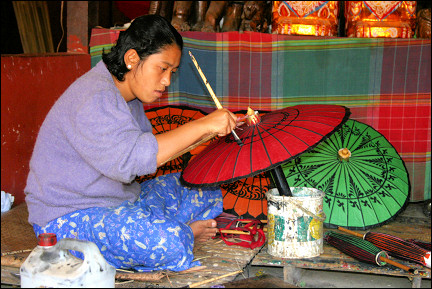 |
Next day we visit a parasol workshop. Everything is made of bamboo. The craftsmanship, the colors: everything is eye candy.
After having spent some time reading in a pagoda, we take the ferry to Yangon. It is a combined cargo and passenger ship. Before we have found a spot for the bicycles and ourselves we are covered in charcoal and white flour. But the trip is fun.
And then we're back where we started, in Yangon. From here we'll fly back home.
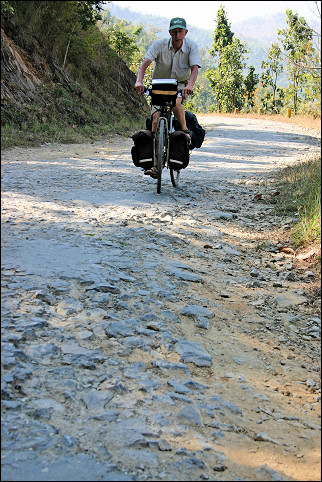 |
It seems a lot longer than five weeks ago when we started this bicycle trip. The most remarkable thing was how nice and helpful people are and how relaxed. Where in the world can you leave your bike, with luggage and cash for five weeks, unattended for an hour near a market or in a village? The only thing they should stop doing is hawking and spitting big red gobs.
If we had any doubts whether to travel to this country which is boycotted by the West, they have disappeared by now. It is our impression that, in the areas where we traveled, politics don not play a big part, in the sense of putting restrictions on people's daily lives. And if they do, for example by blocking popular internet sites like hotmail, etc., people find ways to circumvent those restrictions.
The few times we watched TV in our hotelroom, we were astonished by the state television network. Endless monologues by anchors and officials in a style that reminds of the Soviet heyday.
The most characteristic aspect of Burma or Myanmar though, is its Buddhism. There are more stupas and Buddha statues than Birmese. If all the money that is spent on building and upkeep of the endless numbers of payas would be used for the country's infrastructure, all roads would be smoothly asphalted and electricity would be provided on a regular base, without all the blackouts.
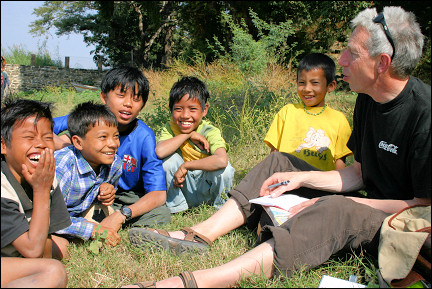 |
But, apart from that, Buddhism is probably also the reason for the friendliness and tolerance of Birmese. Characteristics which make it wonderful to spend a vacation here.